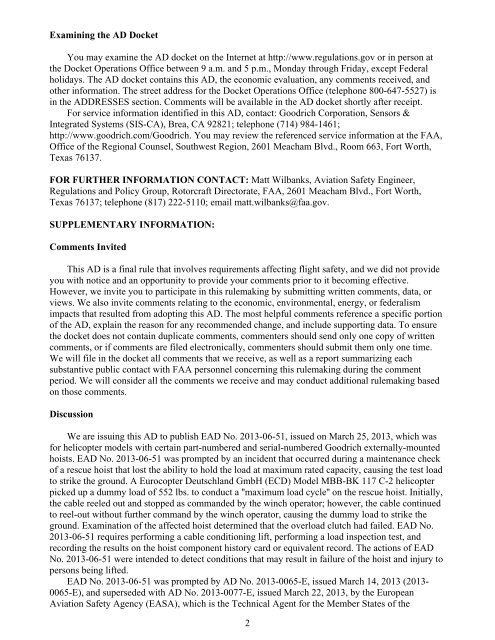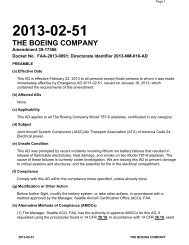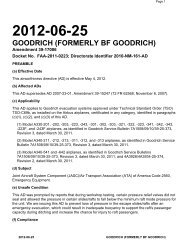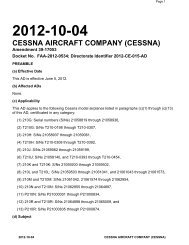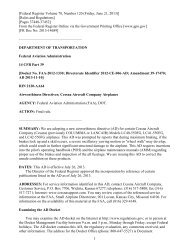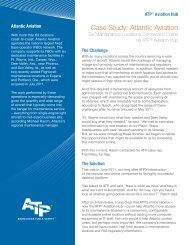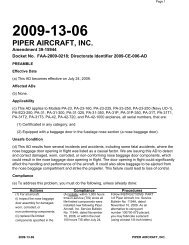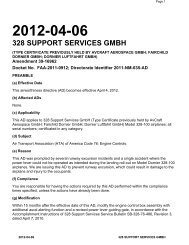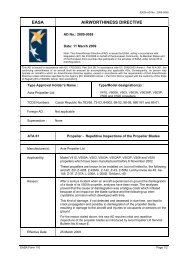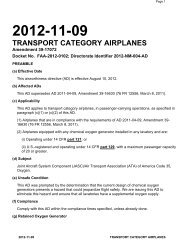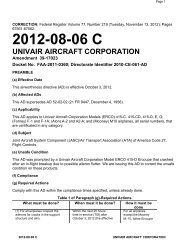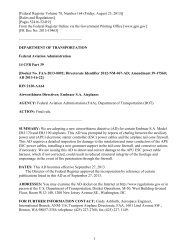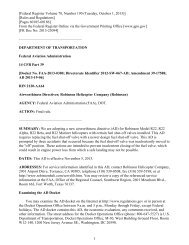AD 2013-06-51 - Civil Aviation Safety Authority
AD 2013-06-51 - Civil Aviation Safety Authority
AD 2013-06-51 - Civil Aviation Safety Authority
Create successful ePaper yourself
Turn your PDF publications into a flip-book with our unique Google optimized e-Paper software.
Examining the <strong>AD</strong> DocketYou may examine the <strong>AD</strong> docket on the Internet at http://www.regulations.gov or in person atthe Docket Operations Office between 9 a.m. and 5 p.m., Monday through Friday, except Federalholidays. The <strong>AD</strong> docket contains this <strong>AD</strong>, the economic evaluation, any comments received, andother information. The street address for the Docket Operations Office (telephone 800-647-5527) isin the <strong>AD</strong>DRESSES section. Comments will be available in the <strong>AD</strong> docket shortly after receipt.For service information identified in this <strong>AD</strong>, contact: Goodrich Corporation, Sensors &Integrated Systems (SIS-CA), Brea, CA 92821; telephone (714) 984-1461;http://www.goodrich.com/Goodrich. You may review the referenced service information at the FAA,Office of the Regional Counsel, Southwest Region, 2601 Meacham Blvd., Room 663, Fort Worth,Texas 76137.FOR FURTHER INFORMATION CONTACT: Matt Wilbanks, <strong>Aviation</strong> <strong>Safety</strong> Engineer,Regulations and Policy Group, Rotorcraft Directorate, FAA, 2601 Meacham Blvd., Fort Worth,Texas 76137; telephone (817) 222-<strong>51</strong>10; email matt.wilbanks@faa.gov.SUPPLEMENTARY INFORMATION:Comments InvitedThis <strong>AD</strong> is a final rule that involves requirements affecting flight safety, and we did not provideyou with notice and an opportunity to provide your comments prior to it becoming effective.However, we invite you to participate in this rulemaking by submitting written comments, data, orviews. We also invite comments relating to the economic, environmental, energy, or federalismimpacts that resulted from adopting this <strong>AD</strong>. The most helpful comments reference a specific portionof the <strong>AD</strong>, explain the reason for any recommended change, and include supporting data. To ensurethe docket does not contain duplicate comments, commenters should send only one copy of writtencomments, or if comments are filed electronically, commenters should submit them only one time.We will file in the docket all comments that we receive, as well as a report summarizing eachsubstantive public contact with FAA personnel concerning this rulemaking during the commentperiod. We will consider all the comments we receive and may conduct additional rulemaking basedon those comments.DiscussionWe are issuing this <strong>AD</strong> to publish E<strong>AD</strong> No. <strong>2013</strong>-<strong>06</strong>-<strong>51</strong>, issued on March 25, <strong>2013</strong>, which wasfor helicopter models with certain part-numbered and serial-numbered Goodrich externally-mountedhoists. E<strong>AD</strong> No. <strong>2013</strong>-<strong>06</strong>-<strong>51</strong> was prompted by an incident that occurred during a maintenance checkof a rescue hoist that lost the ability to hold the load at maximum rated capacity, causing the test loadto strike the ground. A Eurocopter Deutschland GmbH (ECD) Model MBB-BK 117 C-2 helicopterpicked up a dummy load of 552 lbs. to conduct a ''maximum load cycle'' on the rescue hoist. Initially,the cable reeled out and stopped as commanded by the winch operator; however, the cable continuedto reel-out without further command by the winch operator, causing the dummy load to strike theground. Examination of the affected hoist determined that the overload clutch had failed. E<strong>AD</strong> No.<strong>2013</strong>-<strong>06</strong>-<strong>51</strong> requires performing a cable conditioning lift, performing a load inspection test, andrecording the results on the hoist component history card or equivalent record. The actions of E<strong>AD</strong>No. <strong>2013</strong>-<strong>06</strong>-<strong>51</strong> were intended to detect conditions that may result in failure of the hoist and injury topersons being lifted.E<strong>AD</strong> No. <strong>2013</strong>-<strong>06</strong>-<strong>51</strong> was prompted by <strong>AD</strong> No. <strong>2013</strong>-0<strong>06</strong>5-E, issued March 14, <strong>2013</strong> (<strong>2013</strong>-0<strong>06</strong>5-E), and superseded with <strong>AD</strong> No. <strong>2013</strong>-0077-E, issued March 22, <strong>2013</strong>, by the European<strong>Aviation</strong> <strong>Safety</strong> Agency (EASA), which is the Technical Agent for the Member States of the2


